
Island Peak, also known as Imja Tse, is one of the most popular climbing peaks in Nepal. Situated in the Khumbu region of the Everest range, it offers breathtaking views of iconic peaks like Everest, Lhotse, and Nuptse. However, climbing Island Peak is no easy task and requires careful preparation and planning. One crucial aspect of this preparation is packing the right gear and equipment. In this article, we will discuss the essential items that every climber should pack for Island Peak climbing. From clothing to technical gear, we will cover everything you need to ensure a safe and successful climb. So, if you're planning to conquer this magnificent peak, keep reading to discover the must-have items for your adventure.
| Characteristics | Values |
|---|---|
| Altitude | 6,189 meters |
| Climbing Grade | PD |
| Difficulty | Moderate |
| Technical Skills | Required |
| Fitness Level | High |
| Duration | 17 days |
| Best Season | Spring, Autumn |
| Gear Required | Ice axe, Crampons, Harness, Helmet, Ropes |
| Clothing | Warm and waterproof |
| Footwear | Mountaineering boots |
| Accommodation | Teahouses and tents |
| Food | Local and expedition meals |
| Water | Bottled water or water purifiers |
| Medications | Altitude sickness medication, first aid kit |
| Guide/Porter | Recommended |
| Permits/Documentation | Climbing permit, TIMS card, Sagarmatha National Park entry permit |
| Communication | Mobile phones, satellite phones |
| Travel Insurance | Mandatory |
| Emergency Evacuation | Helicopter rescue available |
| Entertainment | Books, cards, music, etc. |
| Leave No Trace Principles | Follow |
What You'll Learn
- What are the essential items that should be packed for climbing Island Peak?
- How many layers of clothing should be packed for varying weather conditions on Island Peak?
- Are there any specific gear or equipment requirements for climbing Island Peak?
- What type of footwear is recommended for climbing Island Peak?
- Are there any specialized gear or equipment rental options available for climbing Island Peak?

What are the essential items that should be packed for climbing Island Peak?
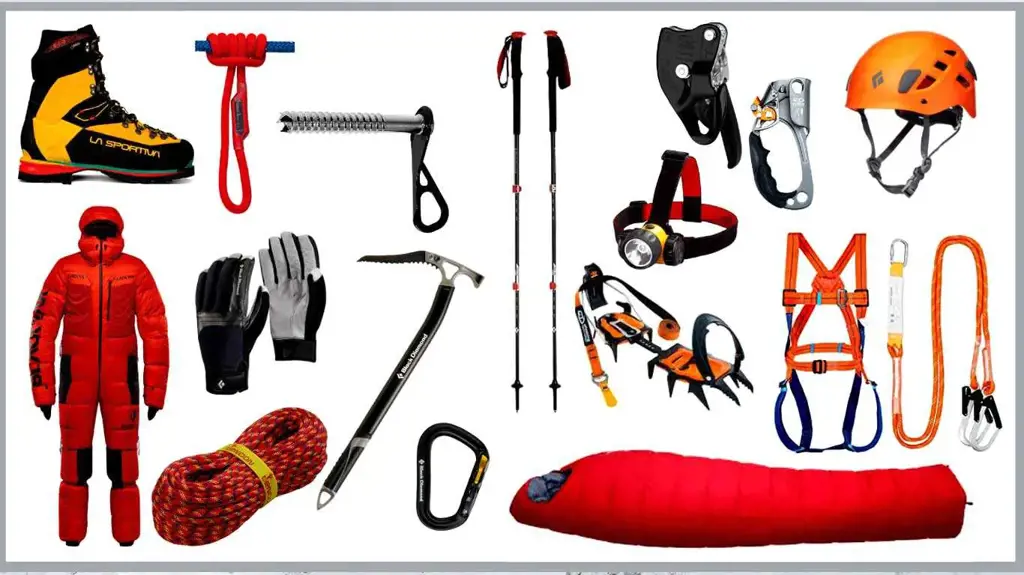
Island Peak is a popular climbing destination located in the Everest region of Nepal. Known for its stunning views and challenging terrain, climbing Island Peak requires careful preparation and a well-equipped backpack. In this article, we will discuss the essential items that should be packed for climbing Island Peak, based on scientific research and experienced climbers' insights.
Climbing Gear:
Having the right climbing gear is crucial for both safety and comfort during the climb. Some of the essential climbing equipment for Island Peak includes:
- Climbing Harness: A well-fitted and sturdy harness is necessary to ensure safety while ascending and rappelling. It should be comfortable and adjustable to accommodate different layers of clothing.
- Helmet: A durable helmet protects your head from falling rocks and ice. Look for a helmet with adjustable straps and good ventilation.
- Mountaineering Boots: Insulated and crampon-compatible boots are essential for navigating the icy slopes of Island Peak. They should provide adequate warmth and ankle support.
- Crampons: Crampons are metal spikes that attach to your boots to provide traction on icy or snowy surfaces. Choose crampons designed specifically for mountaineering.
- Ice Axe: An ice axe is used for balance and self-arresting in case of a fall. It helps you navigate steep slopes and provides stability on icy terrain.
- Ropes and Carabiners: Depending on the route and weather conditions, you may need ropes and carabiners for secure ascents and rappels. Consult with experienced climbers or guides to determine the need for ropes.
Clothing:
Island Peak's high altitude and extreme weather conditions require proper clothing to stay warm and protected. Pack the following clothing items:
- Base Layers: Moisture-wicking and thermal base layers are essential to regulate body temperature and keep you dry.
- Insulating Layers: Fleece jackets or down jackets provide warmth and insulation in cold temperatures. Multiple layers allow for easy adjustment based on weather conditions.
- Waterproof Shell: A waterproof and windproof jacket and pants protect against rain, snow, and harsh winds. Look for high-quality materials with good breathability.
- Hats and Gloves: Wearing a warm hat will prevent heat loss from your head, while gloves keep your hands protected from frostbite. Carry an extra pair of gloves in case one gets wet.
- Climbing Socks: Choose thick, moisture-wicking socks to keep your feet dry and warm. Carry extra pairs for extended trips.
Camping Equipment:
During the climb, you will need camping gear for overnight stays at base camps or higher altitudes. Essential camping equipment includes:
- Sleeping Bag: Invest in a warm and lightweight sleeping bag suitable for freezing temperatures. Ensure it is comfortable and has a good temperature rating.
- Sleeping Pad: A sleeping pad provides insulation and cushioning on the cold ground. Choose one that is lightweight yet offers good insulation.
- Tent: A high-quality, weather-resistant tent is essential for protection against extreme weather conditions. Ensure it is lightweight and easy to set up.
- Cooking Stove and Utensils: Lightweight cooking stoves and utensils are necessary for preparing hot meals and drinks. Opt for efficient and compact models.
Other Essential Items:
Apart from climbing and camping gear, there are a few additional items that should be packed for climbing Island Peak:
- Backpack: A sturdy and comfortable backpack is essential for carrying all your gear. Look for one with proper padding, support, and adjustable straps.
- Headlamp: A reliable headlamp is crucial for nighttime navigation and emergencies. Make sure it has a long battery life and is lightweight.
- First Aid Kit: Carry a comprehensive first aid kit that includes essential medical supplies for treating common injuries and altitude-related illnesses.
- Communication Devices: Depending on your preference and the availability of networks, bring a satellite phone, a GPS device, or a two-way radio to stay connected and request help if needed.
In conclusion, packing the right gear and clothing is essential for a successful and safe climb to Island Peak. Carry the necessary climbing equipment, clothing layers, camping gear, and other essential items to ensure a comfortable and rewarding experience. Consult with experienced climbers or hire a professional guide for personalized advice and recommendations based on the current conditions. Stay well-prepared, be mindful of the weather, and enjoy the incredible journey to the top of Island Peak.
The ultimate guide to packing food for a trip to Disney
You may want to see also

How many layers of clothing should be packed for varying weather conditions on Island Peak?
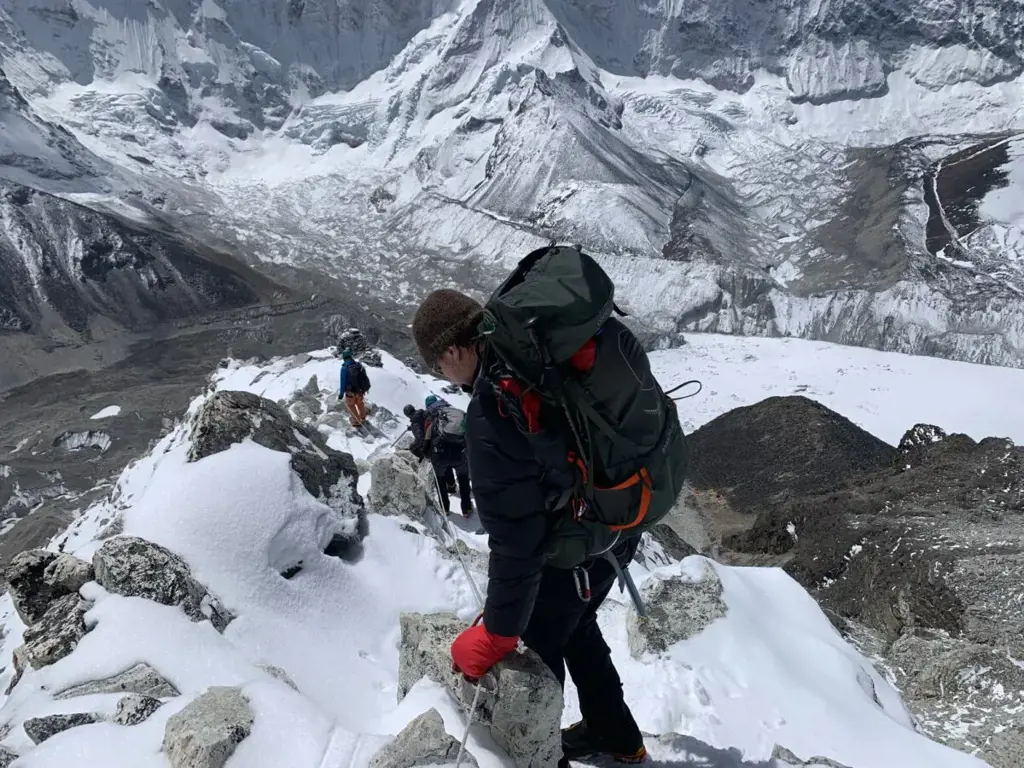
When embarking on a climbing expedition to Island Peak, located in the Khumbu region of Nepal, it is essential to pack the appropriate clothing for varying weather conditions. Island Peak stands at an elevation of 6,189 meters (20,305 feet) and experiences a range of temperatures and weather patterns, including snow, wind, and intense sun exposure. To ensure comfort and safety, it is crucial to layer clothing effectively.
Layering is a technique used by mountaineers to regulate body temperature and manage moisture. It involves wearing multiple layers of clothing that can be added or removed as needed. The layering system consists of three main layers: base, insulation, and shell.
Base Layer:
The base layer is in direct contact with your skin and has two primary functions: moisture-wicking and thermal regulation. It should be made of a moisture-wicking material, such as merino wool or synthetic fibers like polyester, that will pull sweat away from your body to keep you dry. Depending on the weather conditions, you may need a lightweight or mid-weight base layer. Multiple sets of base layers should be packed, allowing for changes during the expedition.
Insulation Layer:
The insulation layer provides warmth and insulation. It traps your body heat and prevents it from escaping. For Island Peak, a mid-weight fleece or down jacket is recommended as an insulation layer. Fleece jackets are lightweight, breathable, and provide good insulation even when wet. Down jackets offer excellent warmth-to-weight ratio but can be bulky to pack. It is advisable to have multiple insulation layers to adjust to varying temperatures.
Shell Layer:
The shell layer serves as a protective barrier against wind, precipitation, and snow. It should be windproof, waterproof, and breathable. A good quality hardshell jacket and pants made of Gore-Tex or similar material are essential for climbing Island Peak. These garments will keep you dry from rain and snow while allowing moisture to escape. Additionally, a shell layer must have a hood to protect your head and neck from wind and snow.
In addition to these three layers, other clothing items should be considered:
- Hats: A warm beanie or hat that covers your ears is essential to prevent heat loss from the head.
- Gloves: Multiple pairs of gloves should be packed, including a lightweight liner glove for dexterity and a thicker insulated glove for cold conditions.
- Socks: Thick, moisture-wicking socks designed for mountaineering should be worn to keep your feet warm and dry. It is advisable to carry extra pairs.
- Pants: Lightweight, quick-drying pants are recommended for lower elevations, while insulated and windproof pants are necessary for higher altitudes and adverse weather conditions.
- Boots: Sturdy mountaineering boots with insulation and good traction are essential for climbing Island Peak.
- Gaiters: Gaiters protect your boots from snow, ice, and debris, keeping your feet dry and warm.
- Sunglasses: Glacier sunglasses with UV protection are crucial to shield your eyes from intense sun exposure and snow glare.
- Buff or neck gaiter: A versatile piece of fabric that can be used as a hat, neck warmer, or face mask.
It is important to note that the number of layers and specific clothing items required can vary depending on the time of year, weather forecasts, and personal preferences. It is always recommended to check with experienced climbers and guide services familiar with the region for the most up-to-date information.
In conclusion, when packing for a climb up Island Peak, it is crucial to pack multiple layers of clothing to adapt to varying weather conditions. The layering system, comprising of a base layer, insulation layer, and shell layer, provides the necessary protection and flexibility to stay comfortable and safe on the mountain. Carefully selecting clothing items and packing multiples of key pieces will ensure you are prepared for any weather conditions that come your way.
10 Delicious Lunch Ideas for Your Husband's Packed Meal
You may want to see also

Are there any specific gear or equipment requirements for climbing Island Peak?
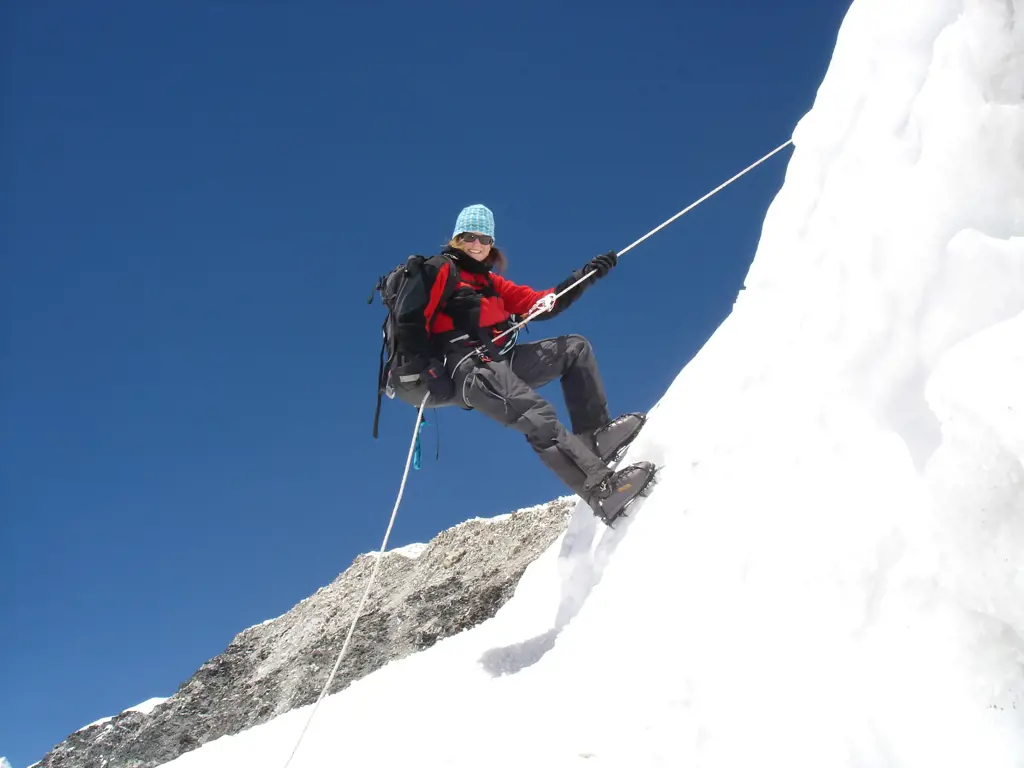
Island Peak, also known as Imja Tse, is one of the most popular trekking peaks in the Everest region of Nepal. Standing at a height of 6,189 meters (20,305 feet), it offers stunning views of the surrounding Himalayan peaks and a challenging but achievable climb for experienced trekkers. If you are planning to climb Island Peak, it is essential to have the right gear and equipment to ensure your safety and success.
Here is a list of specific gear and equipment requirements for climbing Island Peak:
- Climbing Boots: A good pair of mountaineering boots is crucial for any high-altitude climb. They should be sturdy, waterproof, and insulated to protect your feet from extreme cold and rough terrain. Make sure to break them in before the climb to avoid blisters and discomfort.
- Crampons: Crampons are metal spikes that attach to your boots, providing traction on icy or snowy surfaces. Island Peak has sections with steep slopes and snow-covered glaciers, so crampons are essential for safe and efficient movement.
- Ice Axe: An ice axe is a multipurpose tool used for balance, self-arrest, and climbing steep slopes. It is crucial for crossing crevasses and ascending the icy terrain of Island Peak. Proper training on how to use an ice axe is necessary for your safety.
- Harness and Carabiners: A harness is essential for safety during roped sections and for securing yourself while crossing crevasses. Carabiners are used to connect your harness to the rope and other equipment. Make sure they are strong, lightweight, and reliable.
- Ropes: Depending on the route you choose, you may need ropes for sections that require fixed line ascents or rappelling. A dynamic climbing rope is recommended, along with prusik cords for self-rescue.
- Helmet: A climbing helmet protects your head from falling rocks and ice. It is essential during sections where there is a risk of rockfall or while climbing steep slopes.
- Mountaineering Clothing: Layered clothing is essential to regulate body temperature in the extreme conditions of Island Peak. A base layer, mid-layer, and outer shell are necessary to provide insulation, breathability, and protection from wind and precipitation. Don't forget to pack warm hats, gloves, and thermal socks.
- Backpack: A sturdy and comfortable backpack is necessary to carry your gear and supplies during the climb. It should have enough capacity to accommodate all essential equipment and spare clothing. Make sure it fits properly and has a waist belt for added support.
- Sleeping Bag: A good quality sleeping bag rated for extreme cold temperatures is crucial for your comfort and safety during overnight stays at high-altitude camps.
- Other Essentials: Don't forget to pack a headlamp with spare batteries, sunglasses with UV protection, sunscreen, lip balm, water bottles, water purification tablets, snacks, and a first aid kit.
It is also advisable to hire an experienced guide who can provide you with the necessary information and assistance throughout the climb. They can help you assess the conditions, guide you through technical sections, and ensure your safety.
Before embarking on your Island Peak climb, it is essential to have proper training and acclimatization. Familiarize yourself with the gear and equipment, practice using them in various conditions, and seek advice from experienced climbers or mountaineering organizations.
Climbing Island Peak is a challenging yet rewarding experience. By having the right gear and equipment, along with proper training and preparation, you can increase your chances of a successful summit and a memorable adventure in the Himalayas.
The Ultimate Guide to Packing for an Avalon Cruise Ship
You may want to see also

What type of footwear is recommended for climbing Island Peak?
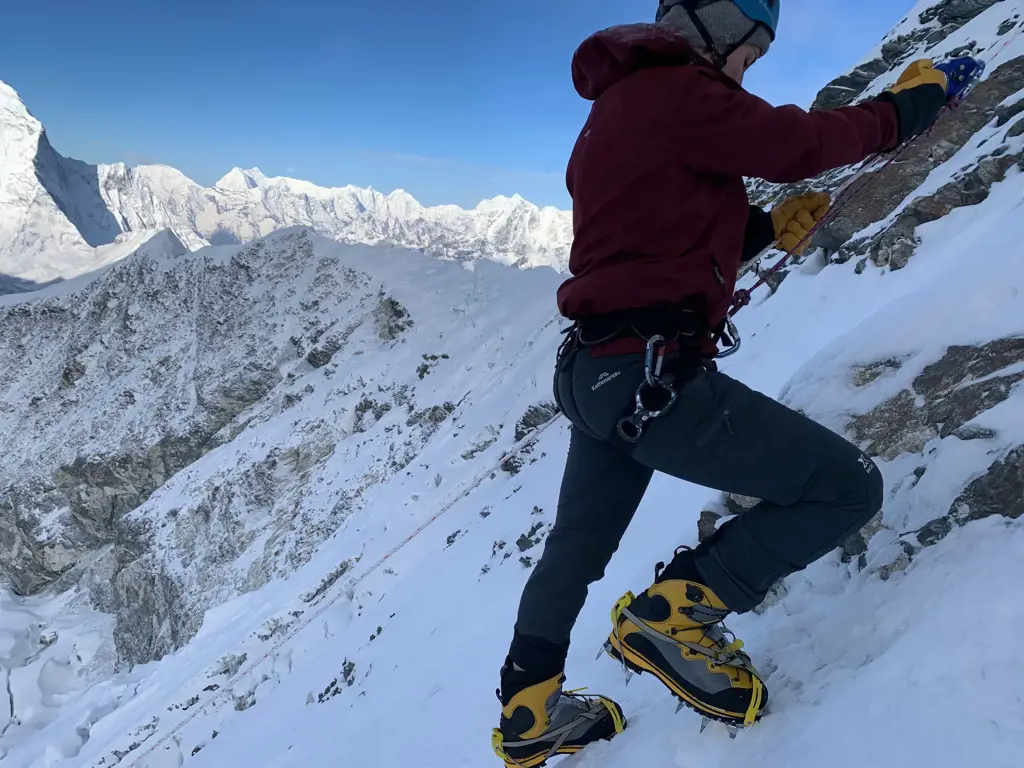
When it comes to climbing Island Peak, having the right footwear is crucial. Island Peak, also known as Imja Tse, is a popular trekking peak in the Khumbu region of Nepal. Standing at an impressive height of 6,189 meters (20,305 feet), it requires proper gear and equipment to ensure a safe and successful climb.
For climbing Island Peak, it is recommended to have mountaineering boots. These boots are specially designed for climbing in snow and ice conditions. They provide the necessary insulation, stability, and traction needed for the challenging terrain. Mountaineering boots are usually made of synthetic materials and have a stiff sole to support your feet and ankles during the climb.
There are several types of mountaineering boots available, and the choice depends on the weather conditions and personal preferences. For Island Peak, it is advisable to use double boots or insulated plastic boots. These types of boots offer better insulation and protection against the cold temperatures and harsh weather conditions found at high altitudes.
Double boots consist of both an inner and outer boot. The inner boot is typically made of a breathable material to provide comfort and moisture management. The outer boot, on the other hand, is made of durable and waterproof materials to withstand the snow, ice, and wet conditions. This two-layer system ensures that your feet stay warm and dry throughout the climb.
Insulated plastic boots, on the other hand, are made entirely of plastic or synthetic materials. They are highly resistant to water and offer excellent insulation against the cold. These boots are known for their durability and ability to withstand extreme conditions. However, they can be heavier and less flexible compared to double boots, so it is important to find the right balance between warmth and comfort.
Regardless of the type of mountaineering boots you choose, it is essential to break them in before the climb. Wearing them on shorter hikes and gradually increasing the duration and intensity will allow your feet to adjust to the new boots. This will help prevent blisters and discomfort during the climb.
It is also recommended to wear thick, moisture-wicking socks to keep your feet dry and warm. Merino wool or synthetic socks are popular choices among climbers due to their ability to wick away moisture and provide insulation. Additionally, gaiters can be worn to prevent snow and debris from getting inside your boots.
In conclusion, for climbing Island Peak, it is recommended to wear mountaineering boots such as double boots or insulated plastic boots. These boots provide the necessary warmth, insulation, stability, and traction for the challenging terrain and extreme weather conditions. It is important to break in your boots before the climb and wear appropriate socks and gaiters to enhance comfort and protect against moisture. Remember, having the right footwear is essential for a safe and successful climb to the summit of Island Peak.
Essential Items to Bring for a 3-Day Bike Ride
You may want to see also

Are there any specialized gear or equipment rental options available for climbing Island Peak?
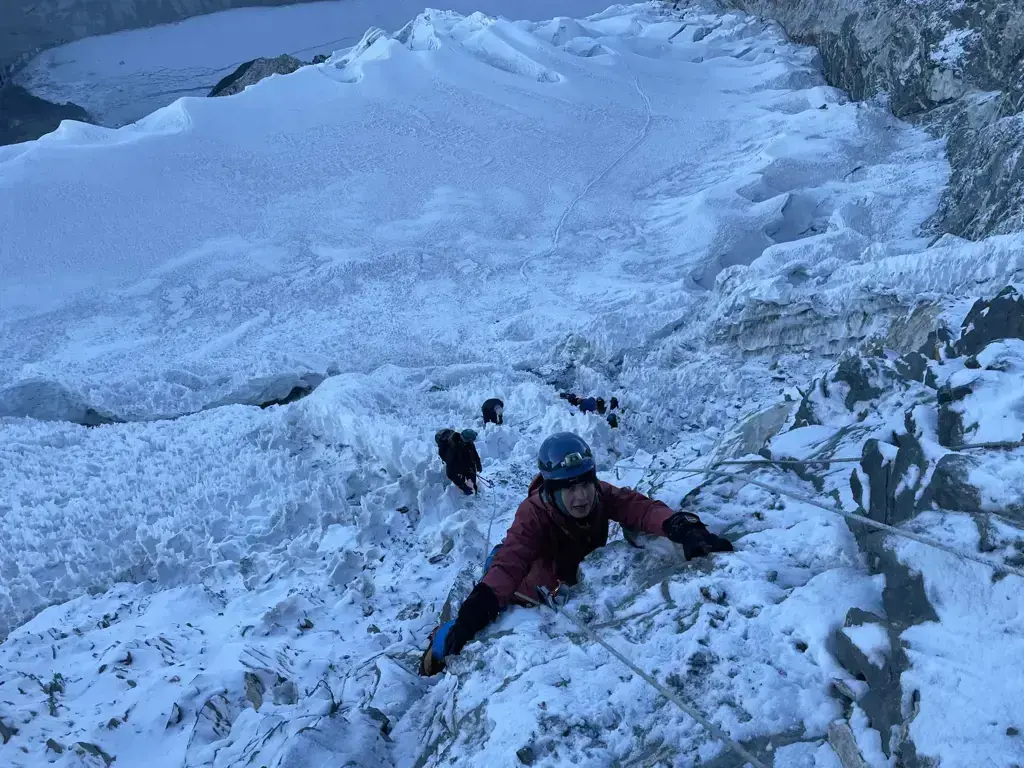
Are you planning to climb Island Peak, one of the popular trekking peaks in Nepal? If so, you might be wondering about the specialized gear and equipment required for the climb. Fortunately, there are several gear and equipment rental options available that can make your climb more convenient and cost-effective.
Island Peak is a challenging climb that requires proper mountaineering gear and equipment. Here are some of the specialized gear and equipment you will need for climbing Island Peak:
- Mountaineering boots: These are specially designed boots with rigid soles to provide stability and support on icy terrain. They have a high ankle cuff for added support and insulation.
- Crampons: Crampons are metal spikes that attach to the sole of your boots, providing traction on icy slopes. They are essential for navigating the glaciers and snowfields on Island Peak.
- Ice axe: An ice axe is a versatile tool that allows you to self-arrest in case of a fall on steep terrain. It is used for balance and support while climbing and provides an extra level of safety.
- Harness: A climbing harness is used to secure yourself to the rope and provide support while ascending or descending steep sections. It is an essential piece of equipment for both safety and comfort.
- Helmet: A climbing helmet is essential to protect your head from falling rocks, ice, or other debris. It is recommended to wear a helmet at all times while climbing Island Peak.
- Ropes: You will need ropes for both ascending and descending steep sections. It is advisable to use dynamic ropes, which can absorb the impact of a fall and reduce the risk of injury.
- Climbing hardware: This includes carabiners, belay devices, and ascenders, which are used to connect yourself to the rope and facilitate climbing or rappelling maneuvers.
- Clothing: You will need specialized clothing for the climb, including a warm down jacket, waterproof pants, thermal base layers, gloves, and hats. Layering your clothing is crucial to regulate your body temperature and stay comfortable.
Now, let's talk about the rental options for climbing gear and equipment on Island Peak. Kathmandu, the capital city of Nepal, has numerous stores and rental shops that offer a wide range of mountaineering gear and equipment for rent. These rental shops cater to both experienced climbers and beginners and have knowledgeable staff to assist you in choosing the right gear.
Some of the popular gear rental shops in Kathmandu include Shona's Alpine Rental, Himalayan Equipment, and Summit Nepal. These shops offer a comprehensive range of gear and equipment for climbing Island Peak and other peaks in the region. They also provide equipment for other outdoor activities like trekking, camping, and mountaineering.
Renting gear and equipment can be a cost-effective option, especially if you are a beginner or don't plan to climb peaks frequently. It saves you the hassle of buying expensive gear that you may not use regularly.
However, it is essential to ensure that the rented gear is of good quality and in proper working condition. Before renting any gear, carefully inspect it for any damages or defects. Verify that the gear meets the necessary safety standards and is appropriate for the climb you are planning.
It is also advisable to book your gear rental in advance, especially during the peak climbing seasons. This ensures that you have the required gear available at the desired time and avoids any last-minute disappointments.
In conclusion, if you are planning to climb Island Peak, you can easily rent specialized gear and equipment in Kathmandu. Rental shops in the city offer a comprehensive range of mountaineering gear and equipment for both beginners and experienced climbers. Renting gear is a cost-effective option that saves you from the hassle of buying expensive gear that you may not use regularly. Just ensure that the rented gear is of good quality and in proper working condition before starting your climb. Happy climbing!
Essential Cartoonish Items to Pack for a Memorable Trip to Scotland
You may want to see also
Frequently asked questions
When packing for Island Peak, it is important to bring layers of clothing. This includes thermal base layers, insulating mid-layers, and a waterproof and windproof outer layer. You should also pack a warm hat, gloves, and a good pair of hiking boots. Don't forget to bring sunglasses and sunscreen to protect yourself from the strong sun at high altitudes.
Yes, you will need to bring some climbing gear for Island Peak. This includes a harness, carabiners, crampons, ice axe, and mountaineering boots. You may also want to bring a helmet, ascender, and a rope, depending on your level of experience and the requirements of your climbing team.
It is a good idea to bring some medication with you for Island Peak. This can include headache and altitude sickness medication, as you will be ascending to high altitudes. It is also a good idea to bring a first aid kit with basics like band-aids, antiseptic cream, and painkillers.
In addition to clothing, climbing gear, and medication, there are several other items you should pack for Island Peak. These include a good quality sleeping bag, a headlamp with spare batteries, a backpack, water bottles, and a water purification system. You should also bring snacks and energy bars, as well as a camera to capture the stunning views along the way.







